Persian campaign of Stepan Razin
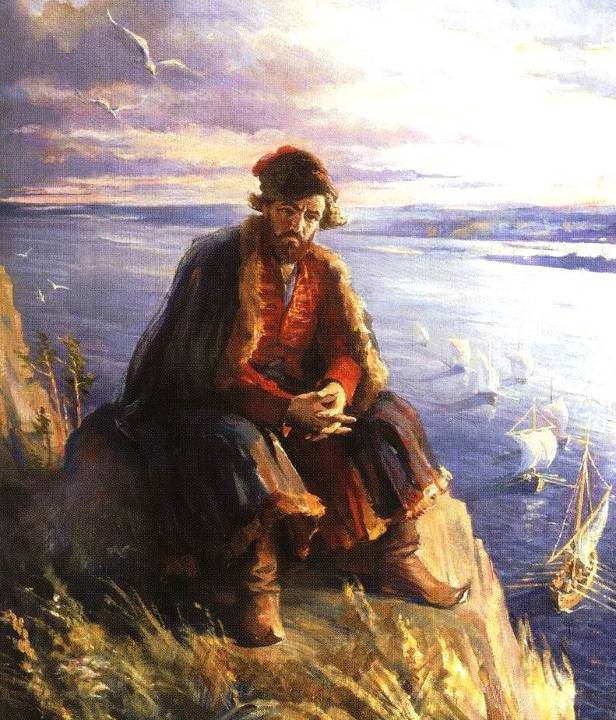
A. Pushkin called Stepan Razin “the only poetic person in Russian stories". One can agree or not that this “person” is the only one, but his “poetry” is beyond doubt. The famous chieftain became the hero of numerous legends (and even epics) and folk songs, the most famous of which is "Razin sees a dream" ("Cossack parable"), recorded in the 1880s "from a 75-year-old old Cossack."
People's memory of Stepan Razin
The attitude of the people towards this chieftain was twofold. On the one hand, people remembered his “robber nature”. And therefore, in some tales, he suffers because of his sins, being unable to die.
Attributed to him and the the Great Martyrdom: "He, in our opinion, as if the devil was"; "He is a wizard who commands the devil."
They believed that the nightmare thrown by the chieftain into water turned into a ship, and Razin could escape from any prison, drawing a boat with coal on the floor or wall.
And on the Lower Volga it was said that Razin once cursed a serpent (sometimes mosquitoes), and they stopped stinging.
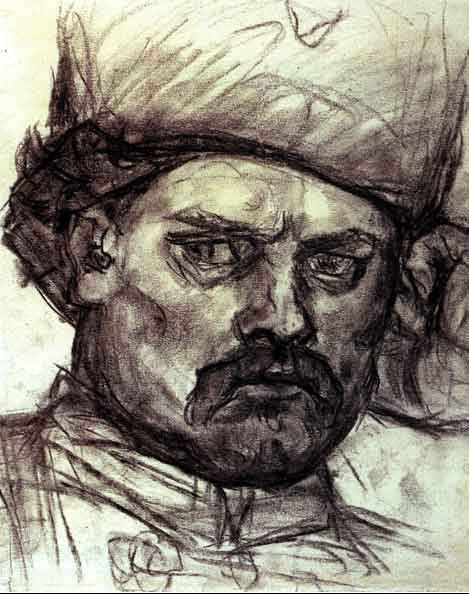
Stepan Razin, drawing by Vasily Surikov
And here is how people explained Razin’s failure at Simbirsk:
He took and shot at the holy cross. As he fired, he doused himself with all his blood, but he was spellbound, but not from this. Frightened and ran. "
Many believed that “it was impossible to take him with any army, because he was a warlock,” “such a word knew that the cores and bullets bounced off him,” and “under each nail he had jumping grass (horse-grass) from which locks and locks themselves fall down and treasures are given. ”
Even after death, Razin allegedly guarded his treasures:
But in some stories, on the contrary, he tries to show his treasure to people, because he can “rest” only when someone finds the main one in Shatrashany:
On the other hand, Razin appears as an intercessor from the arbitrariness of the landowners, boyars and tsarist officials. A. Dumas, who, during a trip to Russia, got acquainted with stories about Razin, in his notes called him “a real legendary hero like Robin Hood.”
Even after the execution of the famous ataman, the people did not want to believe in his death. Moreover, he himself said before the execution:
And then many believed that the legendary chieftain would come to Russia again - to punish the greedy boyars and unrighteous tsarist officials for the insults they inflicted on the people.
N.I. Kostomarov, an old man who remembered Pugachev, said:
The prophecies among the people are also recorded:
"The time will come when he will come to life and again walk on Russian soil."
And such stories about the “second coming of Stenka Razin” were circulated among the people even at the end of the XNUMXth and beginning of the XNUMXth centuries.
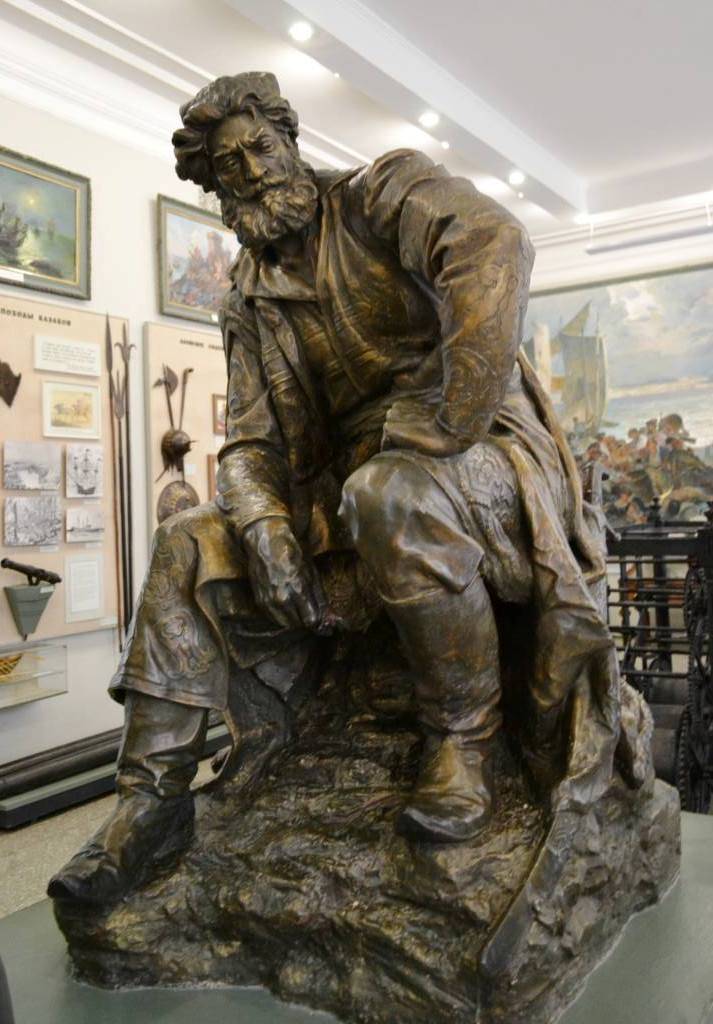
Stepan Razin. Sculpture by E.V. Vuchetich, Novocherkassk Museum of the Don Cossacks
At the beginning of the XNUMXth century, two poems were written about revenge and the “terrible judgment” of Stepan Razin, both from the first person.
The first of them belongs to the pen of A. N. Tolstoy (“The Court”):
They fall for centuries and suck me until the day ...
And I don’t dare to ask for mother earth -
Fight off the serpents and accept me.
Only then, from time immemorial, from Moscow the Throne
My Yasak will strike the steppe Yaik -
I rise, elder, free or involuntary,
And I’ll go through the waters, I am the mother of a Cossack.
Smoke with blood all the forests and rivers;
On the damned marketplace fornication will happen ...
Then the snakes will lift my eyelids ...
And they recognize Razin. And the judgment will come.
Alexei Tolstoy, who wrote these verses in 1911, did not expect anything good from the “Stenka Razin court”. In his lines you hear melancholy and fear of an inevitable and inevitable social explosion: it was already clear to all adequate people that the split and enmity in Russian society had reached their limits, would "explode" very soon, and would not seem to anyone.
At the turn of the 1917th and XNUMXth centuries, rumors began to spread among the people that Stepan Razin was walking along the shore of the Caspian Sea and asking people he met: did they continue to anathematize him, had they begun to light tallow candles in the churches instead of wax ones, had they already appeared on the Volga and on the Don "airplanes and self-floating." In XNUMX, M. Voloshin also wrote a poem about the “court of Stepan Razin,” in which he retold this legend:
Trapped in a coastal sheehan,
Prterperevy from the serpent of mountain
Waiting for news from semi-deciduous countries.
Everything is shining as before - unglazed
Orthodox churches lepota?
Do Stenka curse them Razin
Sunday at the beginning of the post?
Do candles light, yes greasy
In them instead of wax candles?
The governors are okhalnye orders
Do they all follow in their voivodships?
Gorgeous, yes many-sided ...
And out of it even take out the saints.
Something I smell, it's my time
Walk around the Holy in Russia.
And how did I endure the bloody flour
Yes, did not betray Cossack Russia,
So for reprisal on the right
The judge himself tossing and turning in Moscow.
Reason, untie - I will not have mercy, -
Some slams, some priests, some gentlemen ...
So you will know: as before the grave,
So before Stenka all people are equal.
(The Stenkin Court, 1917.)
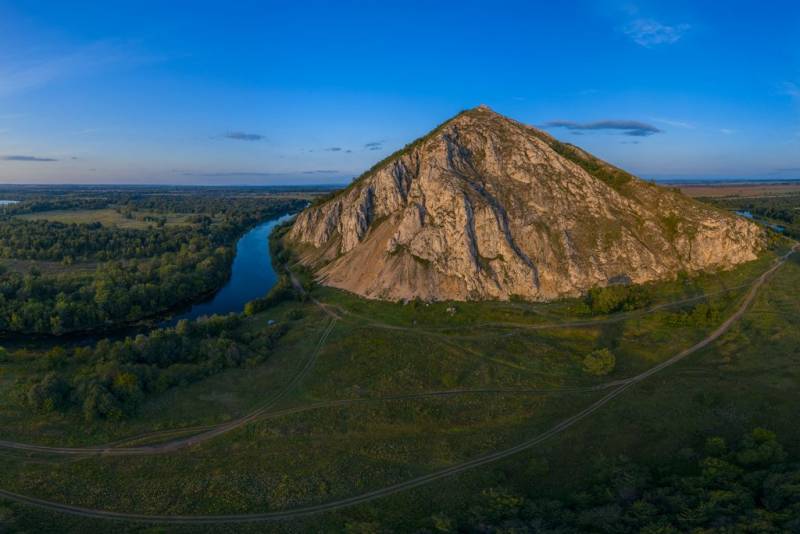
Shihan Yuraktau, Bashkiria. Shihan are called lonely-standing hills or small mountains in the Volga, Urals and Trans-Urals. This is the Shihan of Yuraktau, Bashkiria. In similar, if you believe the legends, and languished, waiting for his time to come, Stepan Razin
You probably noticed that in the poems of A.K. Tolstoy and M. Voloshin some kind of snakes are mentioned: this is a hint of another legend, according to which the “great snake” (sometimes two snakes) sucks Razin’s heart (or his eyes) . These posthumous tortures of the chieftain injured for the people of the ataman raise him to an epic height, putting him on a par with Prometheus.
And after the revolution in the Urals, "tales" were written that Razin presented his sword ... to Chapaev! After World War II, they began to tell that Chapaev chopped the Germans with this saber near Stalingrad.
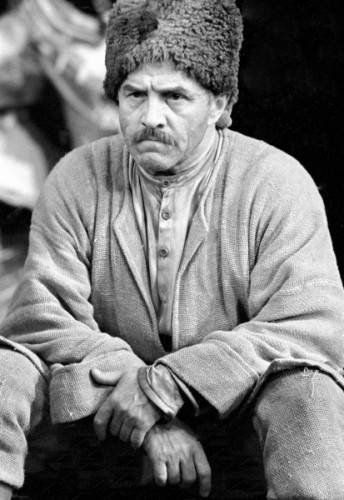
M. Ulyanov as Stepan Razin, 1979
We are now quite well aware of the "Razinshchina" - the Peasant War of 1667-1671. But often the “Persian campaign of this chieftain” remains behind the scenes, which the overwhelming majority of our compatriots know only thanks to the urban romance “From the island to the core” (poems by D. Sadovnikov, the author of the music is unknown). Based on this song V. Goncharov wrote "epic", which was filmed in 1908. This film, which went down in history as the first feature film shot in Russia, is known under three names: "Ponizovaya Volnitsa", "Stenka Razin", "Stenka Razin and Princess".
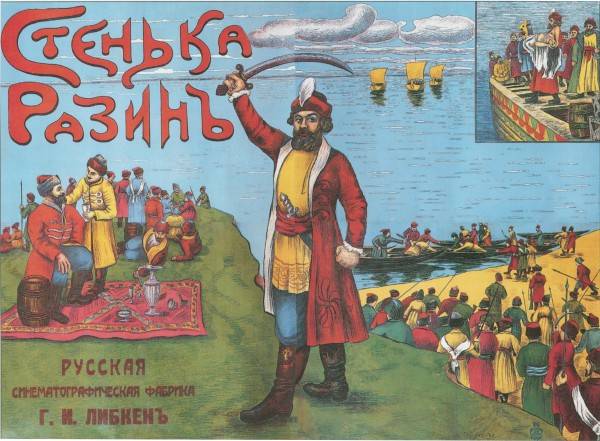
Advertising poster of the film “Stenka Razin” (“Ponizovaya Volnitsa”)
However, in this song the action takes place after the return of the Cossack gang from Persia, and many do not think about how the Persian princess got to Russia and ended up on the stenka of Stenka Razin.
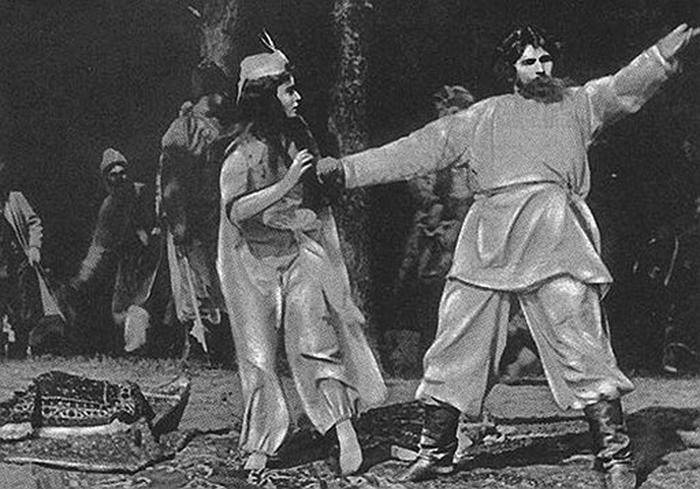
Shot from the film "Ponizovaya Volnitsa"
We will talk about the “Persian princess” in detail in the next article. In the meantime, let's try to recall the history of this campaign of Stepan Razin.
Stepan Timofeevich Razin
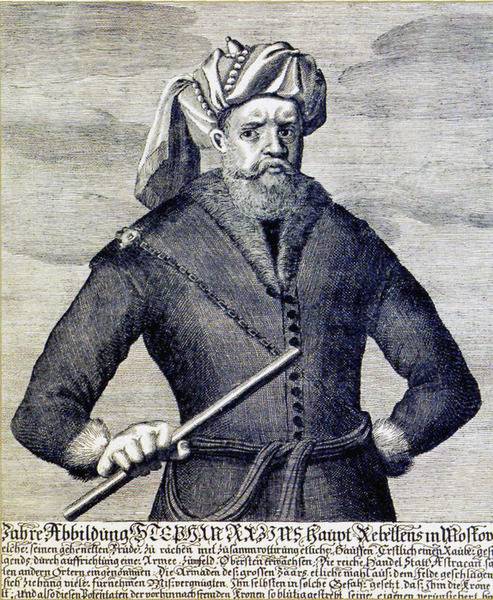
Stepan Razin in XNUMXth-century German engraving, is kept in the library of the University of Heidelberg. Caption below: "A true portrait of the main rebel Stenka Razin in Muscovy"
The birthplace of our hero is traditionally considered the village of Zimoveyskaya (now called Pugachevskaya - Kotelnikovsky district of the Volgograd region). However, this version is still doubtful, since in the historical documents the “Zimoveysky town” was first mentioned in 1672 (and Razin, recall, was executed in 1671). In addition, the village of Zimoveyskaya is the birthplace of Emelyan Pugachev. It is extremely doubtful that two leaders of the Peasant War were born in one place at once, most likely, folk tradition at some point “confused” them, transferring some facts of the biography of Pugachev who lived later on to Razin. Perhaps folk storytellers were also embarrassed by the fact that in the army of Emelyan Pugachev there was a certain Stepan Andreyevich Razin, who could then be ignorant people for a famous ataman who lived 100 years ago.
And in the oldest historical songs, the homeland of Stepan Razin is most often called Cherkassk (now - the village of Starocherkasskaya, Aksay district, Rostov region), less often - Discord, or the towns of Kagalnitsky and Esaulovsky.
Among the Cossacks, Stepan Razin was nicknamed “Tuma” - “half-breed”: they believe that Kalmyk was his mother. We add that, according to some reports, his captive was a Turkish woman, and the godfather - the elected ataman of the Don Army Korniliy Yakovlev, who was called the "Circassian" on the Don. So some “purity of Cossack blood” in those days did not even seem to smell.
The Dutchman Jan Jansen Streus, who met with our hero in Astrakhan, claims that in 1670 he was 40 years old. Thus, he could be born around 1630.
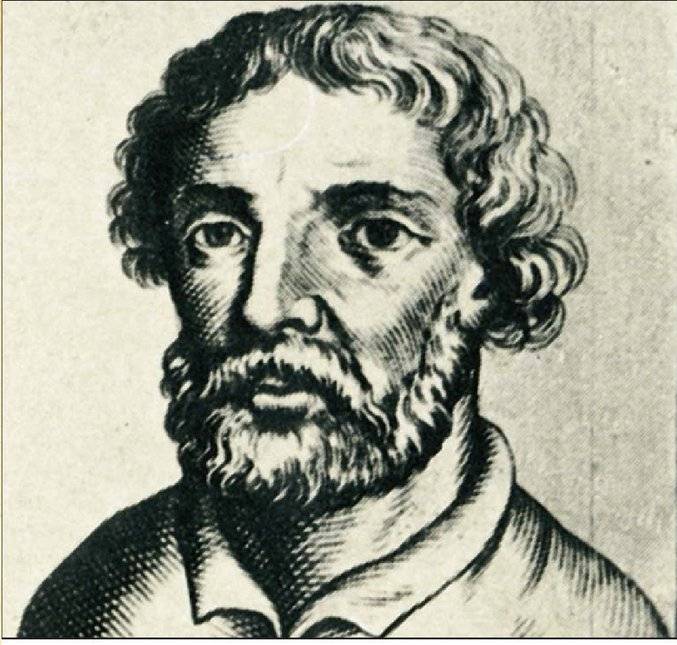
Stepan Razin. Portrait in English engraving, 1672
For the first time on the pages of historical documents the name of Stepan Razin appears in 1652: at that time he was already a field ataman (and his older brother Ivan was a completely ataman of the Don Army). Until 1661, Stepan managed to visit Moscow three times (including as part of the military embassy) and make a pilgrimage to the Solovetsky monastery twice (for the first time - according to a vow, for his father who did not have time to do this). And in 1661, Razin participated in negotiations with the Kalmyks about peace and alliance against the Nogais and Crimean Tatars (along with Fedor Budan and some ambassadors from the Cossacks). In 1663, he led a detachment of Don Cossacks, who went near Perekop along with the Cossacks and Kalmyks. In a battle near Dairy Waters, in alliance with Kalmyks and Cossacks, he defeated one of the Tatar detachments, capturing 350 people.
But in 1665, the tsar’s governor Yu. Dolgorukov executed his brother, Ivan, who, during a campaign against the Poles, wanted to arbitrarily leave his people to the Don. Probably, after this execution Stepan Razin's loyalty to the tsarist government was greatly shaken.
Meanwhile, in 1666, a large number of “cunning” Cossacks — aliens who had no property and land — gathered on the Don. They labored with old Cossacks, were engaged in fishing, and very eagerly went to the notorious “campaigns for zipuns,” which were secretly financed by Cossack foremen for a share in the extraction. In addition to material interest, the Cossack elders had another “interest”: to bring the alien throats away from the Don. They will come from the next trip with prey - well, they will pay a percentage, they will not come - the loss is small, but without them it will be calmer.
In the spring of 1667, the “hooters” gathered for the next such campaign, Stepan Razin became their chieftain. Among his subordinates there were quite a few “quackers” of Vasily Us, who shortly before had pretty much robbed the landowners' estates near Voronezh, Tula, Serpukhov, Kashira, Venev, Skopin and other neighboring cities. The true route was carefully hidden: rumors were circulating about a campaign against Azov. Finally, Razin’s detachment set off: up to two thousand people came to the place of the Volga-Don relics near the cities of Kachalin and Panshin.
Razin at that time, apparently, was a very authoritative “field commander,” the probability of the success of his expedition and gaining profits was estimated as high, and therefore, in addition to the Cossack foremen, Voronezh's “trading people” took part in the outfit of his detachment.
The high authority of Stepan Razin among the Cossacks is also confirmed by the Dutchman Ludwig Fabricius, who served in the Russian army, who speaks of the ataman in his "Notes":
"I will no longer be your chieftain, look for another one," after which everyone fell at his feet and all in one voice asked him to take the saber again. "
Razin ordered overboard not only the Persian princesses to be thrown, but also those who drank during the campaign or stole from comrades. This was a fairly common execution among the Cossacks, which had its own name - "put in water." The offenders were not simply thrown into the “oncoming wave”, but “tied a shirt over his head, poured sand there and threw it into the water” (Fabrizius).
True, upon returning home, the Cossacks, as they say, “blew off the roof”, and they made the spree no worse than filibusters on Tortuga Island and privatirs in Port Royal. And Razin himself, according to the testimony of the same Fabricius, at that time did not lag much behind his subordinates.
Dutch sailing master Jan Streus writes:
But Streus also speaks of high discipline in the Cossack army of Razin during campaigns, reporting, for example, that he ordered one of his Cossacks to be drowned for communication with another man’s wife, and that his mistress should be hanged on a pillar.
He reports that Razin:
And Fabricius writes:
And then:
Only the leader beloved by them and the generally recognized leader could behave this way with those who were not afraid of God or the hell “walking people”.
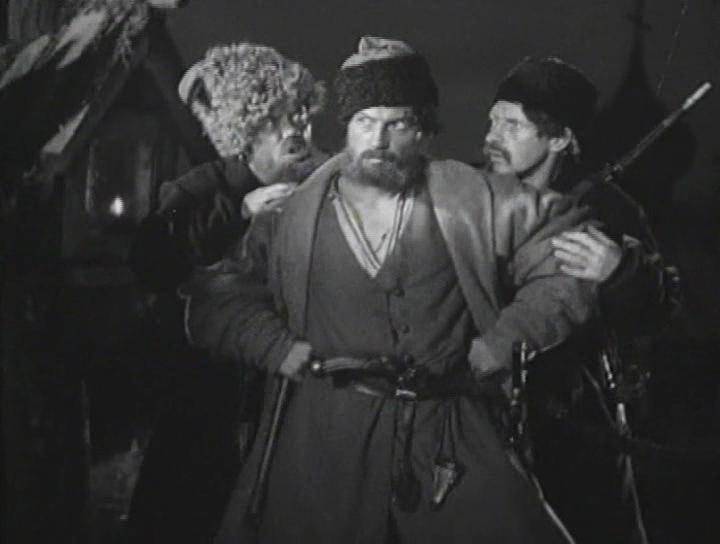
Shot from the film Stepan Razin, 1939
And here is how Razin addressed the archers who went over to his side:
And here is the result:
At the same time, according to the testimony of Streus, the ataman with his comrades "kept himself modest," so that he "could not be distinguished from the rest," but in relation to the "Persian king" he kept himself in relation to such arrogance, as if he himself were king. ”
Beginning of the campaign
So, on May 15 (25), 1667, a Cossack troop on four Black Sea plows and many boats went to the Volga above Tsaritsyn (along the Ilovle and Kamyshinka rivers), where it intercepted the merchant shorin’s trade caravan and robbed the ships of Patriarch Joasaph. At the same time, some archers from the caravan guard joined them, as well as some wells escorted to the Terek and Astrakhan.
Tsaritsyn himself did not begin to touch the Cossacks, demanding only blacksmith's tools, which the local governor resignedly issued to him. They explained his submissiveness, again, with the sorcerers of the chieftain: supposedly, he ordered the governor to shoot cannons at his strings, but not a single one shot.
Soon Razin’s actions went beyond the usual robberies: encircling the strong fortress of Astrakhan, the Cossacks went to the Volga channel Buzan and here they defeated the governor of Chernoyarsk S. Beklemishev, whom the dashing ataman ordered to carve and released. In early June, they entered the Caspian Sea and went to the Yaik (Ural) river, where they captured the Yaitsky stone town (until 1991 it was named after Guryev, now Atyrau, located in Kazakhstan).
It is said that Razin took this fortress by cunning: asking her commandant for permission to pray in a local church. He was allowed to take only 40 people with him, but this turned out to be quite enough: about 170 archers were killed in a short battle, the rest were invited to join the robbery squad, or go on all four sides. Those who decided to leave were caught up and chopped, 300 people joined the Cossacks.
In the Yayitsky town, Razin overwintered, repelling the attack of the three thousandth archery detachment, and replenished his detachment with “hunters.
Persian hike
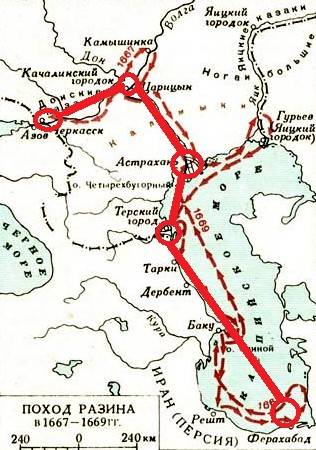
In the spring of next year, ordering to put light cannons on the plows from the fortress towers of the Yaitsky town, Razin went on his famous Persian campaign. Looking ahead, let's say that the small garrison left by him in this city was soon knocked out of it by government forces, so Razin had to go through Astrakhan on the way back. But now Razin led his troops past this city - to the Terek, where another “noble robber” joined him and his detachment - Sergey Krivoy. In addition, the rifle squad of the centurion F. Tarlykov completely sided with Razin. Now that the strength of the Razin detachment reached three thousand people, it was possible to take a walk around the Caspian.
Some unnamed Astrakhan, who then turned out to be in Shemakh on commercial matters, told the authorities when he returned home:
Derbent was captured from the raid, and then Baku, but here the Razinians were too carried away by the “gathering of zipuns”, as a result, the soldiers of the local garrison who left, received reinforcements, attacked the Cossacks scattered around the city and put them to flight. In street battles, Razin lost up to 400 people killed and captured.
After that, Razin sent to Shah Suleiman I (from the Safavid dynasty) ambassadors with a proposal to accept the Cossack army for service and to allocate land for him to settle.
It is not known how serious his proposals were. Perhaps the chieftain only wanted to lull the vigilance of the Persian authorities and gain time. In any case, this attempt at negotiations was unsuccessful: the Razin ambassadors were executed, and the Scottish Colonel Palmer, who arrived to the Shah from Tsar Alexei Mikhailovich, began to help the Persians in the construction of new ships.
Razin resumed hostilities. Part of his detachment entered the city of Farrahabad (Farabat) under the guise of merchants who began to sell looted property at bargain prices - and they "traded" for five days: you can imagine the amount of production already obtained in Persia. It must be assumed that the residents of the city were well aware of the origin of the goods that the Cossacks sold them, but when looking at the price tag, unnecessary questions disappeared by themselves. All the townspeople and even the soldiers of the garrison rushed to the market, where they literally fought for a place in the queue, while the Cossacks at that time broke into Farrahabad and captured it.
Then Rasht and Astrabad (now Gorgan, the main city of the Iranian province of Golestan) were captured and plundered.
After that, Razin decided to winter on the Mian-Kale Peninsula (50 km east of Farahabad). The place turned out to be a swamp, many Cossacks fell ill, while the Persians constantly bothered the aliens with their attacks.
Some researchers believe that Razin saw his famous, foreshadowing death dream, which is described in the “Cossack Parable,” just then - during a difficult winter in Mian-Kale.
In the spring of 1669, Razin led his plows to the southeast, attacking the territories that are now part of Uzbekistan. Here, in the "Trukhmensky land" Sergey Krivoy was lost.
Sailing from here along the eastern shore of the Caspian Sea to the north was impossible due to lack of food, and, most importantly, water. And so the ataman again led his squadron to Baku, where she stood at the so-called Pig Island. According to the most common version, it was Sengi-Mugan ("Stone of magicians" - Persian) - one of the islands of the Baku archipelago. However, some believe that we are talking about the island of Sari. Settling here, the Cossacks again began to devastate the coast.
Naval Battle at Pig Island
In June 1669, the Persian fleet under the command of Mammad Khan (sometimes called Magmedi Khanbek or Menadi Khan) approached this island. The Persians had 50 large ships (Europeans called such ships beads, Russians called “sandalwoods”), on which there were 3700 soldiers.
In the Razin squadron at that time there were 15 naval plows and 8 small shuttles, armed with twenty large and twenty small cannons.
Realizing his superiority, Mammad Khan was already looking forward to victory and brutal reprisals against the Cossacks. The Persians lined their ships, connected in chains, in a line, through which it was almost impossible for light Cossack plows to break through. But Razin ordered the fire to be concentrated on the admiral's ship, and luck was again on the side of the distant chieftain: one of the cores fell directly into the powder chamber of the Persian flagship - and it went to the bottom, dragging neighboring ships connected with it by a chain. The crews of other Persian ships in a panic untied and chopped chains. And the Cossacks on plows approached the Persian ships and shot them with cannons and muskets, or they pushed sailors and soldiers into the water with poles with cannonballs tied to them.
Of the entire Persian fleet, only three ships escaped, on one of which the enemy admiral Mamed Khan also fled. The losses of the Persians amounted to 3500 people, about 200 were killed by the Cossacks. 33 guns were captured, as well as the son of Mamed Khan Shabold (Shabyn-Debye). Some talk about the Khan’s daughter, but let's not get ahead of ourselves - a separate article will be devoted to the “Persian princess”.
This naval battle, of course, should be attributed to the most outstanding victories of the corsair squadrons, Francis Drake and Henry Morgan would respectfully shake hands with Stepan Razin.
Ataman's Triumphant Return
After this battle, the Cossacks marched north for ten days, and luck, as before, smiled at them: on their way, the dashing pirates of Razin met and captured the ship of the Persian ambassador, who brought numerous gifts to the Russian Tsar Alexei Mikhailovich, including thoroughbred stallions.
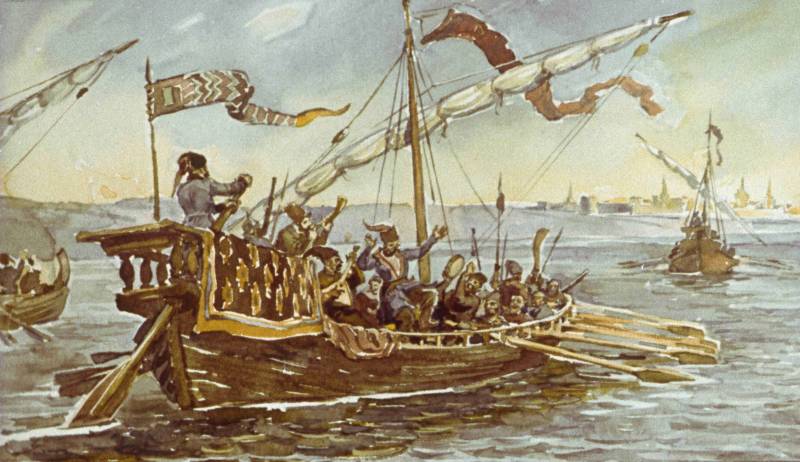
Kosheleva O. E. The Return of the Razin Vataga from Persia to Astrakhan, Frame from the film “The Peasant War Led by Stepan Razin”
The path to the Volga for the Razintsy was reliably closed by the Astrakhan fortress. Ludwig Fabricius reports:
For this, in Astrakhan, he had to give most of the production to the governor I.S. Prozorovsky:
To Astrakhan city
Became governor
Require gifts.
He brought Stenka Razin
Cams are crunchy,
Brocades are golden.
Became governor
Demand a fur coat ...
"Give it, Stenka Razin,
Give the coat from your shoulder!
Give it back, thanks;
If you don’t give it back, I’ll hang it "...
"Welcome, Governor.
Take your fur coat.
Take your fur coat
Yes there would be no noise. "
(A. S. Pushkin, “Songs about Stenka Razin”).
The stallions sent to the king by the shah were also given away. As well as noble captives, sea plows and heavy guns.
In general, the state official pinched the ataman very strongly and sensitively, it is not surprising that then Stepan Razin would hang such “corrupt officials” and “bloodsuckers” very willingly and with great pleasure. But, in the meantime, Stepan Razin paid off the governor, giving him everything he asked. Its entrance to Astrakhan resembled a triumphal procession: the Cossacks were dressed in the most expensive caftans, and the ataman himself threw gold coins into the crowd with handfuls. Then the Razintsy arranged a big sale of booty: Fabricius claims that they sold it for 6 weeks, "during which gentlemen the rulers of the city repeatedly called Stenka to visit them."
In September, Razin with his people in 9 plows, armed with 20 light cannons, sailed from Astrakhan.
When the authorities came to their senses sent after him one of the archery regiments, he in full force went over to the side of the successful chieftain.
Colonel Videros Razin, who arrived to him as an ambassador (to return the fugitive archers), said:
Less than a year later, on June 25, 1670, by the order of Razin, Prozorovsky was thrown from one of the towers of the Astrakhan Kremlin.
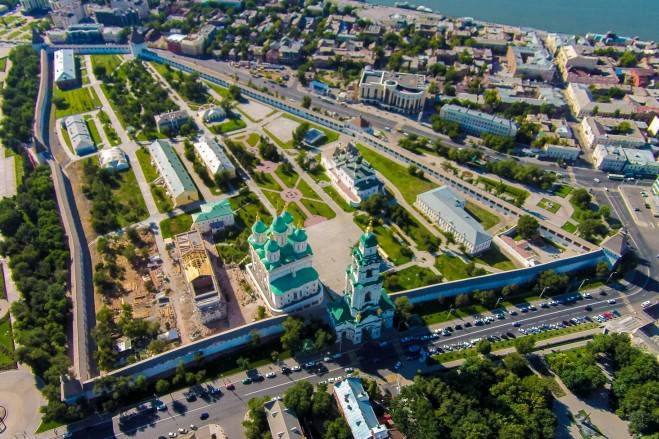
The Astrakhan Kremlin
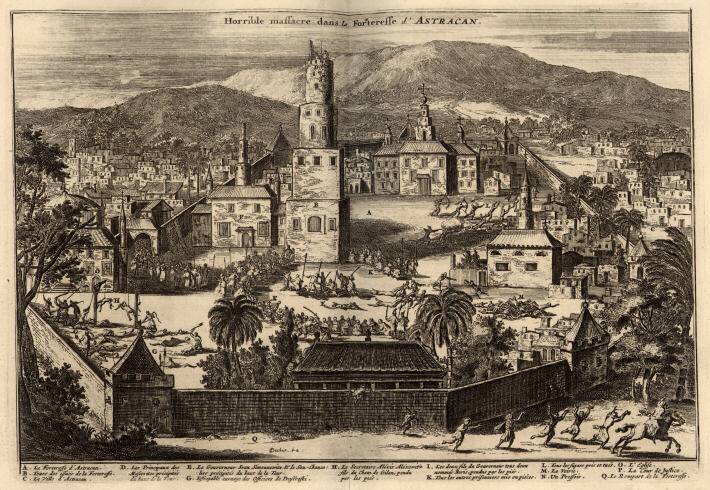
"Atrocities of the Cossacks Stepan Razin in captured Astrakhan." Seventeenth-century engraving from the book of Jan Streus
For the winter, Razin is located in the headwaters of the Don - about two days from Cherkassk.
Tradition says that at that time Razin and his Yesaul Ivan Chernoyarets, Lazar Timofeev and Larion Khrenov buried their treasures near the Kagalnitsky town (now this is the territory of the Azov district of the Rostov region), which he allegedly founded in 1670. However, many believe that this village was founded only in the XVIII century. And the legend about the treasures of the Kagal town was originally associated with the kosman of the Cossacks Petr Kalnyshevsky, who was soon forgotten, replacing his name with the much more famous one - Stepan Razin.
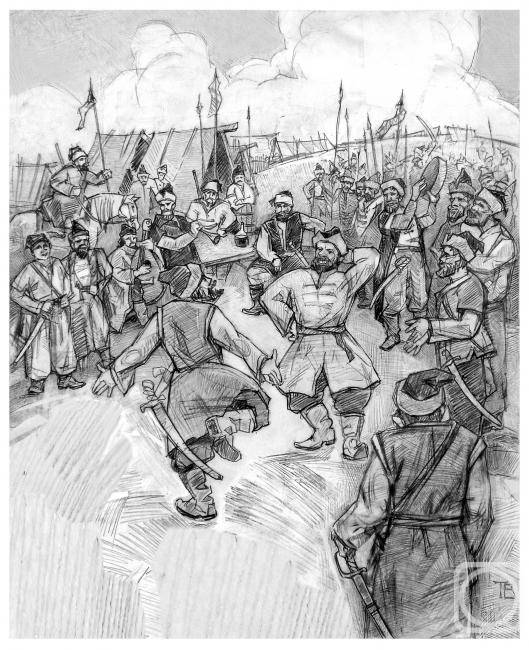
Taranov V. "In the Kagalnitsky town"
Next year, Stepan Razin will again come to the Volga - not the robber ataman, but the leader of the Peasant War, which he will begin under the slogan of extermination of “traitors-boyars, because of which it is difficult for ordinary people to live.”
But this is a different story, which we may return to later. And in the next article we will talk about the mysterious "Persian princess" who became a prisoner of Razin.
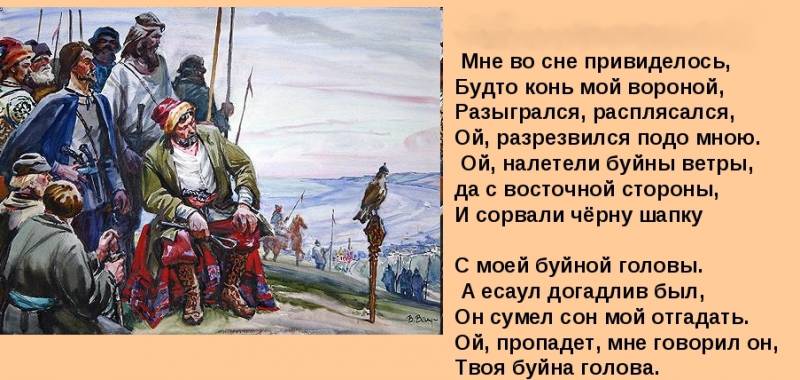
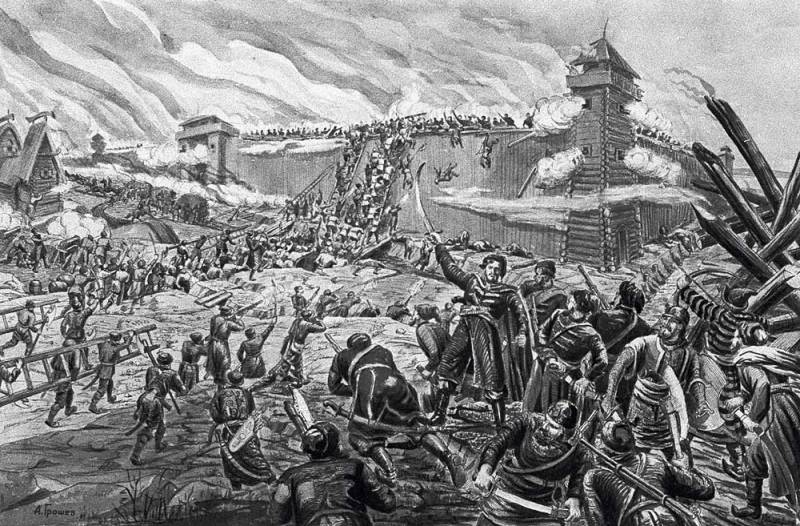
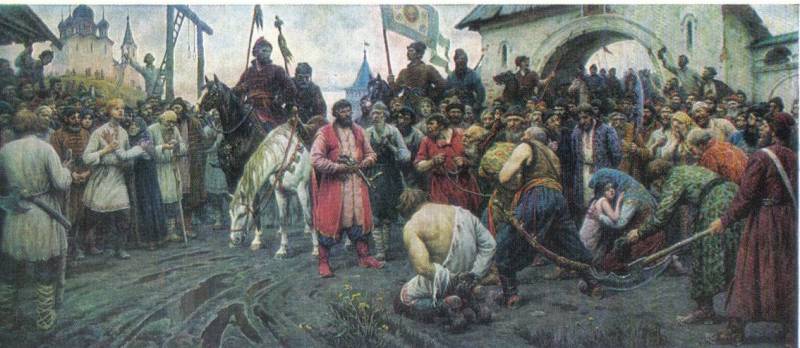
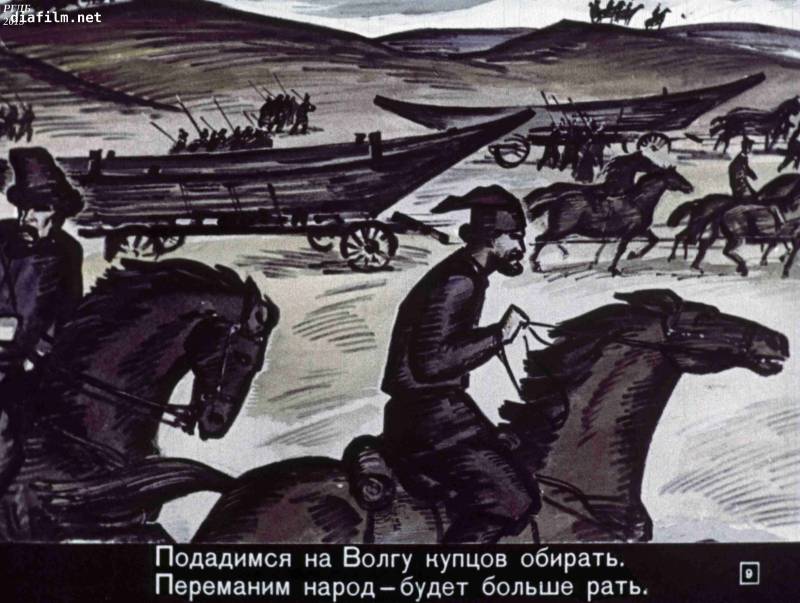
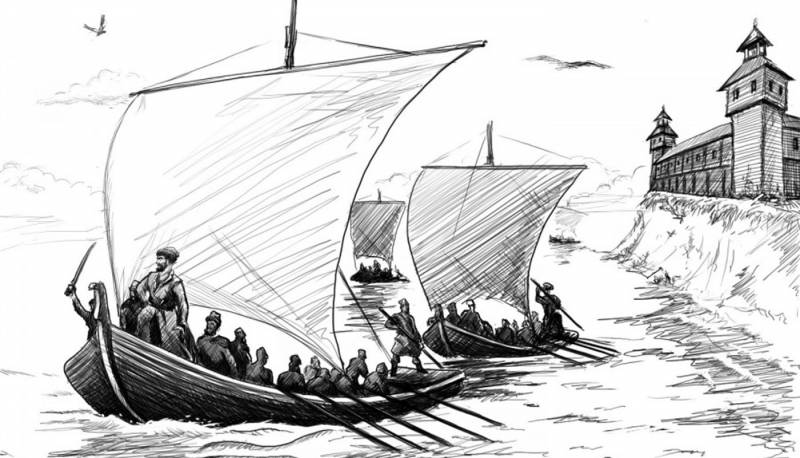

Information